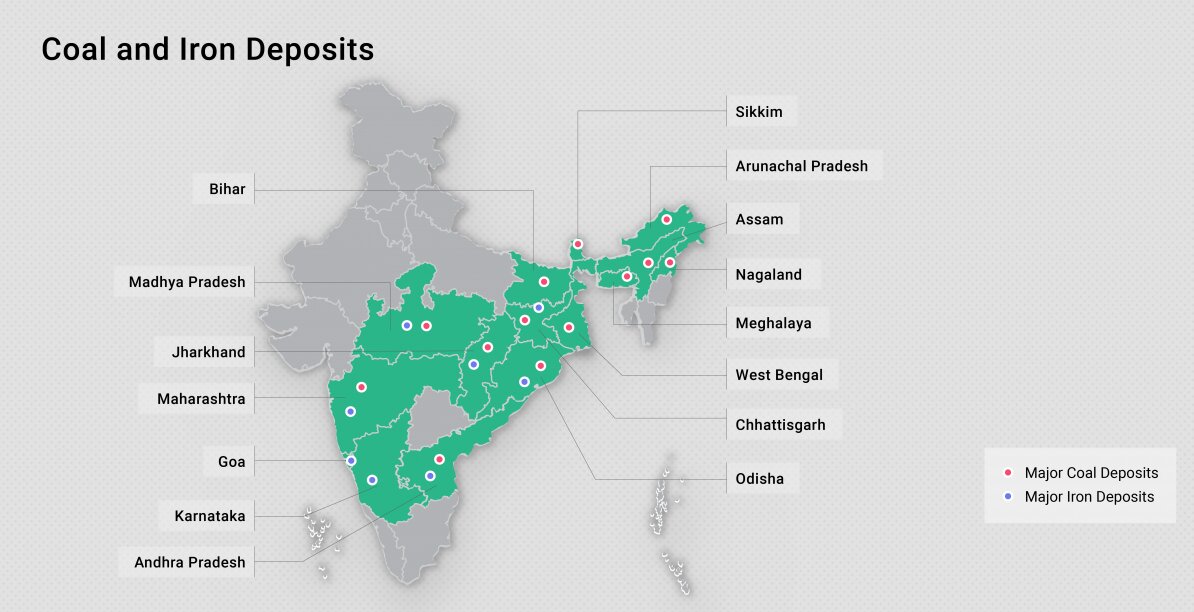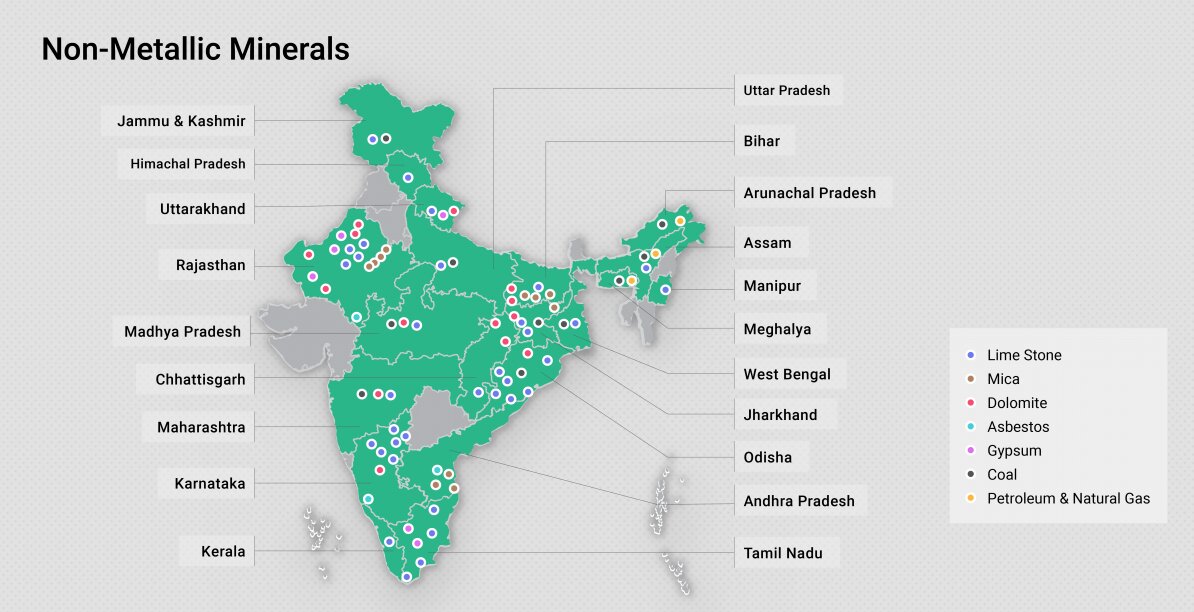Mining Sector in India | 03 May 2019
Why in News?
- India has recorded 377 mine deaths in last 3 years [as per data tabled in Lok the Sabha].
- India plans to deep dive for extracting seabed minerals.
Background
- The total geographical area of India is around 328 million hectares out of which mining lease (other than fuel, atomic and minor minerals) constitutes around 0.14%, barely 20% of it is mined.
- The Indian subsoils are rich in onshore and offshore crude oil and gas, coal, iron ore, copper, bauxite, etc.
- India has large reserves of iron ore, bauxite, chromium, manganese ore, baryte, rare earth and mineral salts. India produces as many as 95 minerals, which includes 4 fuel, 10 metallic, 23 non-metallic, 3 atomic and 55 minor minerals (including building and other materials). In 2015-16, there were more than 2,101 reported mines excluding the atomic and minor minerals, natural gas and petroleum (crude).
Role of Mining in Indian Economy
- Indian economy is expected to grow by approximately 7% in the years to come. Sectors like infrastructure and automobiles will receive a renewed thrust, that would further generate demand for power and steel in the country. The mining sector provides raw materials to these fast-growing sectors.
- The total value of mineral production (excluding atomic & fuel minerals) during 2017-18 has been estimated at $16.6 bn, which shows an increase of about 13% over that of the previous year.
- The mining sector’s contribution to the GDP is 2.3-2.5 % at present. Mineral production in India grew at a compound annual growth rate (CAGR) of 5.72% between 2013-14 and 2017-18.
- It can cut down the import costs as the country is the 3rd largest steel producer, with a production of 101.4 million tonnes of crude steel in 2017.
- India is the largest producer of sheet mica in the world and has the 7th largest bauxite reserves at around 2,908.85 million tonnes in FY17.
- It is a labour-intensive sector and provides employment for both unskilled labour and skilled labour. Being a part of the primary sector, it largely provides unskilled jobs.
- The Development of the mining-based industry also gives a boost to the associated industries and leads to the overall development of the region.
Geographical Distribution of Mines
The Legislative Framework of Mining Sector in India
- The entry at serial No. 23 of List II (State List) to the Constitution of India mandates the state government to own the minerals located within their boundaries,
- The entry at serial No. 54 of List I (Central List) mandates the central government to own the minerals within the exclusive economic zone of India (EEZ). In pursuance to this Mines & Minerals (Development and Regulation) (MMDR) Act of 1957 was framed.
- International Seabed Authority (ISA) regulates mineral exploration and extraction. It is guided by the UN treaty and India being a party to the treaty has received an exclusive right to explore polymetallic nodules over 75000 sq. km in Central Indian Ocean Basin.
- The MMDR Amendment Act of 2015 introduces Mineral Concessions Grant through auctions to bring transparency and remove discretion; The District Mineral Foundation (DMF) to address the longtime grievance of the people affected by mining; and the National Mineral Exploration Trust (NMET) for incentivising regional and detailed exploration to fill the gaps in exploration in the country, and stringent measures to check illegal mining.
The National Mineral Policy 2019
It includes provisions which will give a boost to the mining sector such as:
- Encouraging the private sector to take up exploration, on a revenue sharing model.
- Provision of merger and acquisition of the mining entities and transfer of mining leases and creation of dedicated mineral corridors, and use of coastal waterways and inland shipping for evacuation and transportation of minerals to boost private sector mining areas.
- It also mentions long term import-export policy for mineral, which will help the private sector in planning and bring stability in business.
- The policy also makes efforts to harmonise taxes, levies, and royalty with the world benchmarks to help the private sector.
- Provisions for e-governance, IT-enabled systems, awareness and information campaigns have been incorporated for regulations.
- The utilisation of the District Mineral Fund for the equitable development of project affected persons and areas.
- It also introduces the concept of intergenerational equity that deals with the well-being not only of the present generation and also of the generations to come.
- It also proposes to constitute an inter-ministerial body to institutionalise the mechanism for ensuring sustainable development in mining.
Challenges/Concerns Faced by Mining Sector in India
- Displacement and rehabilitation issues
- Large scale displacement of local people leads to grievances and improper rehabilitation measures, thereby, leading to people’s alienation and develop distrust over the government machinery.
- It's not just a loss of land for the local population rather the loss of a tribal way of life and their rich cultural heritage.
- It has given space to left-wing extremism in the resource-rich areas like Chhattisgarh, Jharkhand, Odisha, etc.
- Mining also puts the lives of miners at risk due to the rudimentary ways adopted and the absence of adequate safety gear and protocols. For instance, mine-related accidents at Ksan coal mine in Meghalaya- Jaintia Hills (2018), Chasnala near Dhanbad in 1975.
- Human Rights violations have taken place in forms of mine-related deaths, inadequate rehabilitation, and developmental steps, etc. Massive local protests have taken place against mining in Niyamgiri Hills of Odisha, POSCO in Odisha, Sterlite protest in T.N.
- Rathole mining: This is a form of illegal mining, especially practised in North eastern areas like Meghalaya (Ksan coal mine incident). It involves digging of very small tunnels [only of 3-4 feet high], done both vertically and horizontally. The NGT banned it in 2015 on the grounds of it being unscientific and unsafe for workers.
- The coal seam is extremely thin in Meghalaya, no other methods would not be economically viable. Removal of rocks from the hilly terrain and putting up pillars inside the mine to prevent collapse would be costlier. In Meghalaya, this is the locally developed technique and the most commonly used one.
- Environmental/Health issues
- Environmental pollution has been caused by the Makrana marble mines in Rajasthan, the Granite mines of Karnataka have left a large hole on earth, Damodar river has been severely polluted by coal mining.
- Loss of biodiversity and local heritage due to mining activities.
- The prevalence of mining in an area causes various diseases like fibrosis, Pneumoconiosis, and silicosis in workers as well as locals.
- Water Pollution – water from streams and rivers in mining areas have become acidic and unfit for drinking. Eg: Meghalaya’s Kopili river, Damodar river etc.
- Contaminated air with high particulate matters is also a major problem in mining rich regions.
- Administrative issues
- Arbitrary allocation of coal mines leads to the long litigation and eventually cancellation of allocations and charges of corruption in block allocations.
- Delay in environmental clearances due to bureaucratic hindrances.
- Judicial interventions lead to long delay and losses for investors. For ex: SC imposed a heavy penalty on illegal mining without green clearances in Andhra Pradesh, Telangana, Karnataka, and Odisha in 2017. Banning of Vedanta group in Niyamgiri Hills of Odisha and shut down of 88 illegal mining leases in Goa in 2018.
- Government’s initiatives
- Star rating of mining leases to establish a sustainable development framework for the Indian mining sector.
- An MoU was signed between the Indian Bureau of Mines (IBM) and the National Remote Sensing Centre (NRSC), ISRO in January 2016 to undertake a pilot project on “monitoring of mining activities using satellite imagery” to deter illegal mining.
- The Mining Surveillance System (MSS) is launched to check illegal mining through automatic remote sensing detection technology.
- District Mineral Foundation Fund (DMF) was established for the welfare of mining-affected people and areas under Pradhan Mantri Khanij Kshetra Kalyan Yojana [PMKKKY].
- The National Mineral Exploration Policy has been released to attract private exploration agencies.
- 100% FDI permitted via automatic route for mining and exploration of metal and non-metal ores. And approval route for mining of titanium bearing minerals and its ores.
Way Forward
- There is a need for an expedition of the clearance process for the judicious utilisation of mineral resources.
- Stringent implementation of mining-related rules is needed especially regarding the ban on Rat-Hole and unscientific mining to prevent mine-related accidents.
- Ensure transparency in block allocations and rule-based order should be established.
- Use of technology for a better way of mineral exploration and surveillance systems.
- Proper rehabilitation of the displaced population, the tribal rights need to be respected in accordance with the law.
- Proper environmental impact assessment (EIA) and social impact assessment (SIA) must be conducted before allocating the projects.
- Utilisation of DMF to construct physical & social infrastructure and efforts should be made for the integration of the local population in the process.
- A proper regulatory framework for the implementation of the NGT guidelines for the protection of forest and the least damage to the environment.
- Adopting global practices in operations and ensuring safe working conditions for workers in the mining sector. Undertake measures to avoid occupational hazards.


